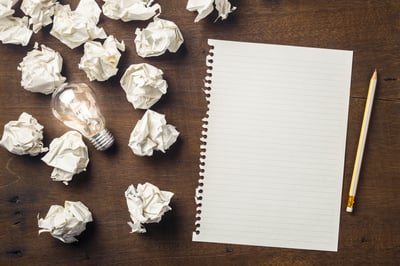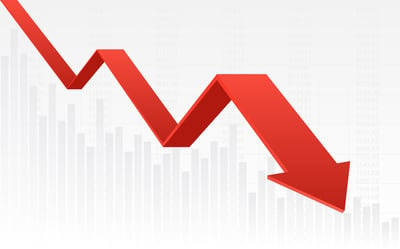April 18, 2019
 by Mary Clare Novak / April 18, 2019
by Mary Clare Novak / April 18, 2019

Knowledge is power.
That statement has never been more accurate than it is right now. The evolution and history of communication tell us that we are currently in the Information Age, a time when wisdom is the key to success. The best way to pass wisdom along is through communication.
Already familiar with the basics? Feel free to jump ahead:
With strong communication, spreading knowledge is smooth like peanut butter. Or almond butter. Or cashew butter. Or whatever the kids are eating these days.
Communication is constant. Even when our mouths are shut and our phones are locked, we are sending messages.
Communication is the process of sending and receiving information. There are four different types of communication that each include at least one channel. Choosing the right type of communication and channel is crucial when sending a message, as they both affect the way the information is delivered.
Now that we have that definition in mind, let's dive into the details of how communication works, the different types of communication, and skills you need to be an effective communicator.
Because communication is such an effortless common occurrence, it is a strange thought that the process has more than one step. However, communication theory tells us something different.
Communication theory is the scientific study of sending and receiving information. Under communication theory, there are different models that apply to different situations. It can get a little heavy, so I’ll break down the most important parts.
The communication process typically includes four elements: sender, message, channel, and receiver.

Not so complicated, right? We send information using communication channels and then the message is received in one way or another. Well, unfortunately, it’s not that simple.
A lot more needs to be considered. When communicating in a new circumstance, with a new person, or through a new channel, taking a step back and asking yourself these questions will ensure effective communication.
Consider the parties involved in the communication. Their communication skills, attitudes, knowledge, and backgrounds might affect the way they deliver or interpret a message.
Take a look at the information you are sharing. The content, structure, and elements paired with it can make or break the effectiveness of a message.
This question takes into account both the message and the parties involved. Make sure the channel you are using is appropriate for the communicators involved and the information being sent. Certain topics are best discussed in person, while others are perfectly fine being sent in an email. Also, some people might prefer a specific channel over another.
Distractions, varying information, and unrelated facts can get in the way of a message’s purpose. Take those into account and find ways to make the message as clear as possible.
All communication, whether we think about it or not, has a desired effect. It can be as simple as sharing information or as complicated as changing someone’s behavior. Recognize your message’s purpose and craft it to get your desired effect.
Communication works in mysterious ways. Taking an extra minute to consider the individual components of a message will help you construct the best message for your current situation.
Choosing the right channel is an important step in the communication process. But before you choose a channel, you must select the appropriate type of communication. Don’t worry, you have options. There are four main types of communication: verbal, nonverbal, written and visual. Understanding the appropriate time and place for each is a necessary step in developing your communication skills.
Verbal communication is the use of speech to share information. Because it is the most personal way to communicate, learning effective verbal communication is crucial to the development and maintenance of all relationships.
When communicating verbally, we need to consider two factors: word choice and tone. The words we choose should reflect the knowledge levels of the audience. Speak simply to people learning about a new topic, and save the jargon for talking with industry experts. Our tone, or attitude, is also dependent on the audience. We should be more formal when speaking with our boss than when we are joking around with friends.
Thanks to communication technology, communicating verbally can happen using methods other than talking in person, such as via telephone or with video conferencing software. This channel is especially useful when someone is out of reach, but you still want the conversation to be as personal as possible.
Nonverbal communication is the way we send messages without speaking. No matter how thoughtless, our actions speak volumes. Understanding what certain actions imply is important when sending and receiving information.
Our bodies include a lot of communication methods. Facial expressions, body language, and eye contact are good indicators of emotion, energy, and interest. Make sure your nonverbal cues show that you are listening, engaged, and energetic, even if that isn’t really the case.
Paying attention to nonverbal cues is important in understanding someone’s current state. If a person is slouching or yawning while speaking, it’s pretty obvious they don’t care so much about the information they are presenting. But when someone is making eye contact, sitting up straight, or nodding in agreement, they are sending a positive message about themselves.
Written communication is using the written word to share information. Because written communication channels are concrete, this is the best method for sharing large amounts of important information that will likely be revisited at a later time.
Like verbal communication, word choice needs to be considered when sending a written message. Be aware of complicated industry terms and jargon. A common misconception of writing is that the more fancy words you use, the smarter you sound. The opposite is actually true. Writing that is simple and concise is the true sign of knowledge on a topic.
Written communication channels have also advanced with the help of technology. Using a pen and paper to write a message will never go out of style. However, email and instant messengers have become common tools in personal and professional conversations.
Visual communication is sending information in forms that can be seen. When communicating number-heavy materials or providing examples, pairing them with a form of visual communication can be beneficial to the receiver.
Visual communication can take a few forms. Graphs, photographs, models, and objects all give message receivers a break from written or spoken words and provide them with another way to go about understanding something. Recognize when a visual would help your audience, and provide one when necessary.

No matter the type of communication you use, your method will use one of these four communication styles: passive, aggressive, passive-aggressive, and assertive. However, only one of these styles will give you your desired effect.
Let’s take a look at each one.
Passive communication is used when people wish to come across as indifferent about the topic at hand. They support all opinions, no matter how they feel or how different the opinions are.
The passive communication style is ineffective because when people don’t honestly voice their own opinions, the information is limited to the ideas of those that do.
Aggressive communication is used when people overpower the conversation with their own thoughts and refuse to listen to the ideas of others.
Being aggressive is not a good way to communicate. It intimidates others from sharing their own thoughts and defeats the purpose of a conversation, which is to share and discuss ideas.
A passive-aggressive style is used when people come across as if they don’t care about something, but in a way that is indirectly angry and accusatory.
This style of communication is also ineffective because it is dishonest. People who use this communication style don’t express the way they really feel and instead use ambiguous language, leaving other involved parties left to interpret a confusing message.
Being assertive is the most effective way to communicate. With this style, people express their thoughts, ideas, and opinions while also respecting and listening to those of others.
Assertive communication includes offering ideas, asking for feedback, and then actually listening to it. All ideas are expressed, heard, and respected.
It can be easy to speak passively when shy, aggressively when angry, and passive-aggressively when feeling both. However, to be an effective communicator and have a worthwhile conversation, we must be assertive.
Lacking communication skills is a common flaw. If you have this problem, making an effort to fix it is worth your while. Miscommunication can lead to a lot of problems. Avoid them with these communication tips!
Listening is arguably the most important part of communication. If a message is sent and no attention is paid to it, the information is lost. Be attentive and take the speaker’s ideas into account before giving feedback. This shows that you have given them your full attention instead of just waiting for your turn to talk.
Understanding your audience is key to crafting an effective message. To fully understand your message, some people might need background, explanations, and clarification. Get a feel for their current understanding of the topic you are presenting and adjust your delivery accordingly.
Don’t forget about nonverbal communication. We are constantly communicating with our bodies, whether it is intentional or not. Focus on the nonverbal cues of a speaker to better understand their message, and make sure that your nonverbal cues match the message you are trying to send. If you are trying to excite coworkers about the company retreat while leaning back in your chair and crossing your arms, they won’t buy it. Actions speak louder than words.
Give your written communication a second glance before presenting it. Read your message out loud or have a second pair of eyes read it over to help you pick up on typos or grammatical errors.
If you are feeling uneasy about how a message was sent or accepted, redeliver it. It’s better for a message to be received more than once than not received at all.
Questions, comments, and clarifications are a natural part of the communication process. It welcomes new insights and ideas, strengthening the conversation. Taking feedback into consideration can also help you craft better messages in the future.
Give your audience some important points to keep in mind. This will help them organize their thoughts while they are deciphering the bulk of the information. Towards the end of the message, reiterate those points so they walk away with them.
There are a lot of different ways to communicate, but no matter which one you use, use these etiquette tips to be heard -- without being offensive.
Effective communication is necessary for all relationships. Whether you are managing employees or nurturing a companionship, there can be no growth without effective communication. With honest communication comes problem-solving, loyalty, and trust.
Want more detail on communication? Head over to our resource on the types of communication!
Mary Clare Novak is a former Content Marketing Specialist at G2 based in Burlington, Vermont, where she is explored topics related to sales and customer relationship management. In her free time, you can find her doing a crossword puzzle, listening to cover bands, or eating fish tacos. (she/her/hers)
Communication is related to every human activity.
 by Mary Clare Novak
by Mary Clare Novak
“I love you.” “Your paycheck has been delivered.”
 by Mary Clare Novak
by Mary Clare Novak
“Let me paint you a picture.”
 by Mary Clare Novak
by Mary Clare Novak
Communication is related to every human activity.
 by Mary Clare Novak
by Mary Clare Novak
“I love you.” “Your paycheck has been delivered.”
 by Mary Clare Novak
by Mary Clare Novak


